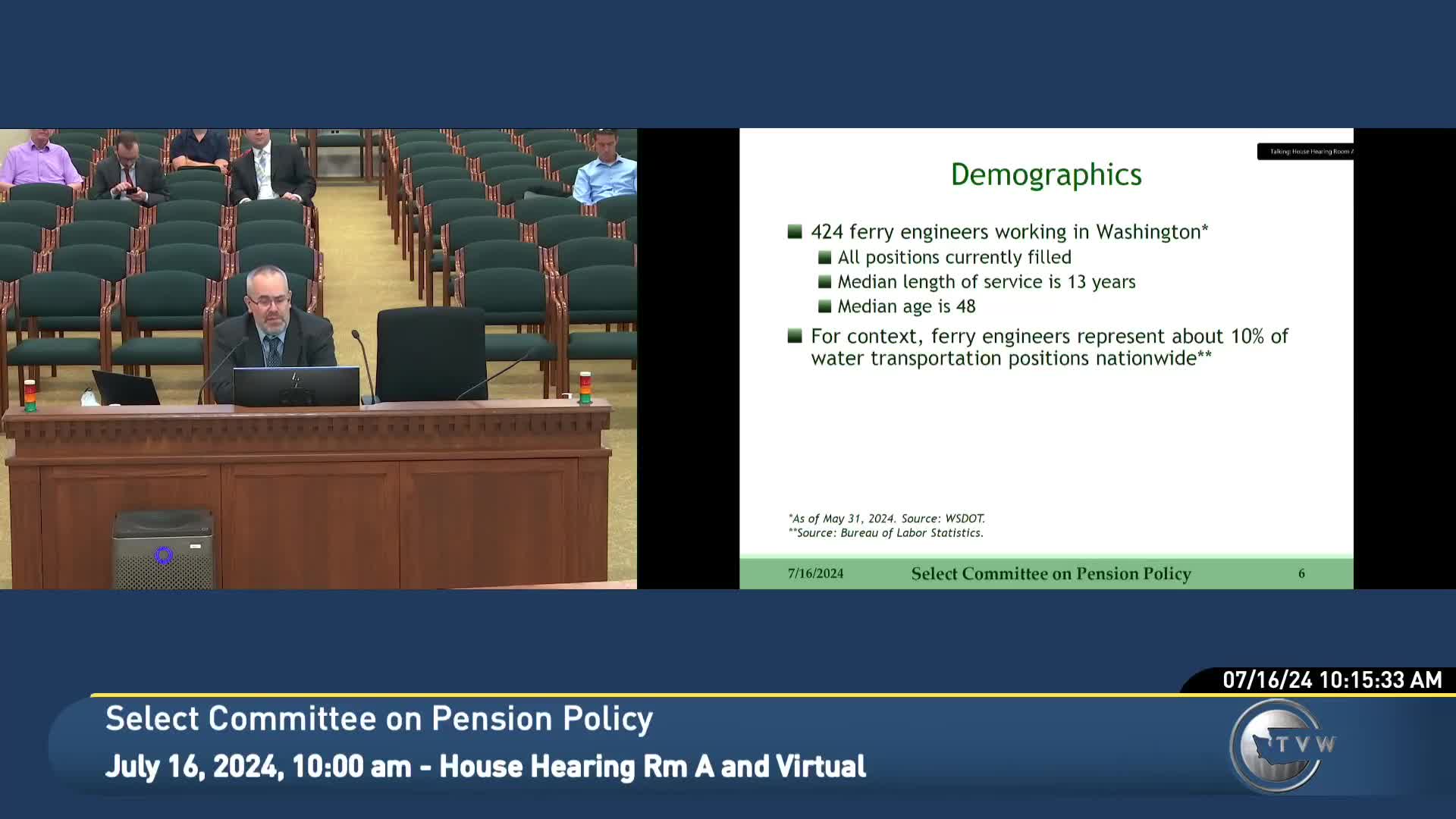Disability Benefits Debate Sparks Concerns for Ferry Engineers
July 16, 2024 | Select Committee on Pension Policy, Joint, Work Groups & Task Forces, Legislative Sessions, Washington

This article was created by AI summarizing key points discussed. AI makes mistakes, so for full details and context, please refer to the video of the full meeting. Please report any errors so we can fix them. Report an error »

In a recent government meeting, discussions centered on the disability benefits and employment conditions for ferry engineers, who represent approximately 10% of water transportation positions nationwide. The median age of these workers is 48, with an average length of service of 13 years.
Key points highlighted included the current salary structure, which took effect on July 1, and the guaranteed 88 hours of work every two weeks for ferry engineers. The meeting also addressed the complexities surrounding disability benefits, particularly in relation to the Jones Act, which governs maritime law and provides rights for injured sailors. Under this act, ferry engineers injured during employment can seek compensation from multiple parties, including their employer, which in this case is the state.
The discussion revealed that ferry engineers are part of the Public Employees Retirement System (PERS), receiving similar benefits to other members. However, there are concerns regarding the adequacy of these benefits, especially for those who suffer disabling injuries. Currently, PERS disability benefits require total incapacitation for qualification, a standard that stakeholders argue may be too stringent. They are advocating for a broader definition that includes those unable to meet certification requirements due to injury.
The meeting also touched on the certification standards set by the Coast Guard, which are critical for ferry engineers. These standards may include physical requirements such as vision, which could impact an individual's ability to work. Senators raised concerns about the reliance on certification standards as a qualifier for early retirement, suggesting that the focus should be on the severity of the injury rather than the ability to recertify.
In conclusion, the committee is considering whether the current disability benefits are sufficient for ferry engineers and whether adjustments are necessary to better accommodate their unique job risks. Further analysis and discussions are expected in future meetings, with potential coordination with other relevant entities to explore options for improving the benefits system.
Key points highlighted included the current salary structure, which took effect on July 1, and the guaranteed 88 hours of work every two weeks for ferry engineers. The meeting also addressed the complexities surrounding disability benefits, particularly in relation to the Jones Act, which governs maritime law and provides rights for injured sailors. Under this act, ferry engineers injured during employment can seek compensation from multiple parties, including their employer, which in this case is the state.
The discussion revealed that ferry engineers are part of the Public Employees Retirement System (PERS), receiving similar benefits to other members. However, there are concerns regarding the adequacy of these benefits, especially for those who suffer disabling injuries. Currently, PERS disability benefits require total incapacitation for qualification, a standard that stakeholders argue may be too stringent. They are advocating for a broader definition that includes those unable to meet certification requirements due to injury.
The meeting also touched on the certification standards set by the Coast Guard, which are critical for ferry engineers. These standards may include physical requirements such as vision, which could impact an individual's ability to work. Senators raised concerns about the reliance on certification standards as a qualifier for early retirement, suggesting that the focus should be on the severity of the injury rather than the ability to recertify.
In conclusion, the committee is considering whether the current disability benefits are sufficient for ferry engineers and whether adjustments are necessary to better accommodate their unique job risks. Further analysis and discussions are expected in future meetings, with potential coordination with other relevant entities to explore options for improving the benefits system.
View full meeting
This article is based on a recent meeting—watch the full video and explore the complete transcript for deeper insights into the discussion.
View full meeting
